
Excertos do catálogo
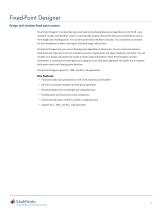
Fixed-Point Designer Design and simulate fixed-point systems Fixed-Point Designer™ provides data types and tools for developing fixed-point algorithms in MATLAB® code, Simulink® models, and Stateflow® charts. It automatically proposes fixed-point data types and attributes such as word length and rounding mode. You can also specify these attributes manually. You can perform accelerated bit-true simulations to observe the impact of limited range and precision. Fixed-Point Designer lets you convert floating-point algorithms to fixed point. You can create and optimize fixed-point data types that meet your numerical accuracy requirements and target-hardware constraints. You can simulate your design and analyze the results to obtain range information. Fixed-Point Designer uses this information to recommend word lengths and scalings for your fixed-point algorithm and enable you to compare fixed-point results with floating-point baselines. Fixed-Point Designer supports C, HDL, and PLC code generation. Key Features ▪ Fixed-point data type specification in MATLAB, Simulink, and Stateflow ▪ Bit-true, accelerated simulation of fixed-point algorithms ▪ Recommendations for word length and scaling data type ▪ Floating-point and fixed-point results comparison ▪ Fixed-point data type override to double or single precision ▪ Support for C, HDL, and PLC code generation
Abrir o catálogo na página 1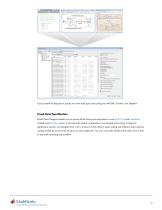
Using Fixed-Point Designer to specify and view data types and scalings for MATLAB, Simulink, and Stateflow. Fixed-Point Specification Fixed-Point Designer enables you to specify all the fixed-point properties of your MATLAB code, Simulink models, and Stateflow charts. It provides full control of signedness, word length, and scaling. It supports application-specific word lengths from 1 bit to at least 128 bits. Binary-point scaling and arbitrary slope and bias scaling needed by sensors and actuators are also supported. You can control the details of the math, such as how to deal with...
Abrir o catálogo na página 2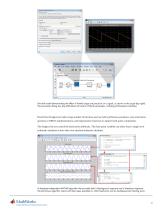
Simulink model demonstrating the effect of limited range and precision on a signal, as shown on the scope (top right). The parameter dialog box (top left) allows full control of block parameters, including all fixed-point attributes. Fixed-Point Designer provides a large number of functions such as math and bitwise operations, array and matrix operators, CORDIC implementations, and trigonometric functions to support fixed-point computation. The designer lets you control the fixed-point arithmetic. The fixed-point variables can either share a single set of arithmetic attributes or have their...
Abrir o catálogo na página 3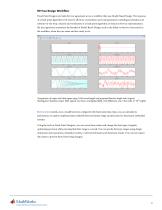
Bit-True Design Workflow Fixed-Point Designer provides bit-true agreement across a workflow that uses Model-Based Design. The response of a fixed-point algorithm is bit-true for all forms of simulation and code generation, including acceleration and software-in-the-loop. Analysis and verification of a fixed-point algorithm are based on bit-true representations. Bit-true agreement maximizes the benefits of Model-Based Design, such as the ability to discover issues early in the workflow, when they are easier and less costly to fix. Comparison of output with data types using 16-bit word length...
Abrir o catálogo na página 4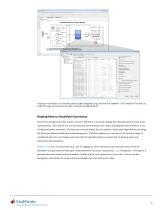
ftt VVw Dlfpl*? P-^Mrn iinsminn A-MK-Hl C«k M H(lp Fault-Tolerant Fuel Control System Fixed-point simulation of a fuel rate control system designed using Simulink and Stateflow. The Fixed-Point Tool lets you trade off range and precision for data in Simulink models (bottom). Floating-Point to Fixed-Point Conversion Fixed-Point Designer provides analysis tools for efficiently converting a design from floating-point to fixed-point representation. The tools let you record minimum and maximum data values and pinpoint when overflows occur during fixed-point operations. The data type override...
Abrir o catálogo na página 5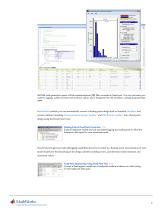
H NurnericTyp«St(]|M - ^Jit^circJjLjff _typ«d: y Fife View HeJp S^nedncH: Signed MA7LAB code generation report of finite impulse-response (F!R) filter converted to fixed point. You can instrument your code for logging, collect minimum and maximum values, plot a histogram from the simulation, and get proposed data For Simulink models, you can automatically convert a floating-point design built in Simulink, Stateflow, and system toolboxes including Communications System Toolbox™ and DSP System Toolbox™ into a fixed-point design using the Fixed-Point Tool. UKrtV wed* smuBKM wuqt O * ] .3....
Abrir o catálogo na página 6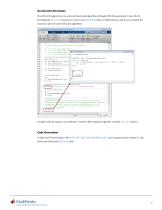
Accelerated Simulation Fixed-Point Designer lets you accelerate fixed-point algorithms through MEX-file generation. It does this by providing the f iaccel function to convert your MATLAB code to a MEX-function, which can accelerate the execution speed of your fixed-point algorithms. Breatponrs Run Run and ftunand u& Advi I x| is the input signal vector -■ Create the Input Signal and y ■ fi | Zeros (size (x) ) ,tcue( 16,1. 44 Enin Normal Mode fia-CCSl lia^sl Feedback -ar eedback Code a Ccda acaeleratim prcvides optimizations far accelerating fixed-point 1 algorithms ehn/ugh MEX file...
Abrir o catálogo na página 7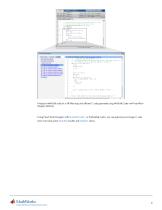
Static Cods Ma an ITS Report B Targal Source Files Ml lit lil' cirt Euff frped awe gen iHi&3lia.H Fixed-point MATLAB code for a F!R filter (top) and efficient C code generated using MATLAB Coder with Fixed-Point Designer (bottom). Using Fixed-Point Designer with Simulink Coder™ or Embedded Coder, you can generate pure integer C code from your fixed-point Simulink models and Stateflow charts. Accelerating the pace of engineering and science
Abrir o catálogo na página 8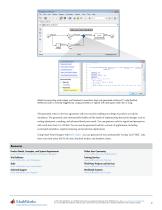
File Edit View Display Diagram Simulation Analysis Code Tools Help iMuti-WordCode Generation! Ceta Type CbrroreiCT FixedStcpDise rete- ll I CodF Generation Report Subsystem Report Code l-it-:-rof.; ^ii-innr Static Cade Metrics Report Code Replacements Report Generated Code [ ] Main file fxpdemo mijltiwofd.c Model incorporating wide integer and fixed-point operations (top) and generated multiword C code (bottom). Multiword code is normally triggered by using parameters or signals with data types wider than C long. The generated code is in bit-true agreement with your model, enabling your...
Abrir o catálogo na página 9Todos os catálogos e folhetos técnicos The MathWorks
-
MATLAB Production Server
6 Páginas
-
Database Toolbox
4 Páginas
-
MATLAB Report Generator
4 Páginas
-
Stateflow
8 Páginas
-
SimEvents
7 Páginas
-
SimDriveline
7 Páginas
-
SimHydraulics
7 Páginas
-
SimPowerSystems
8 Páginas
-
Simulink Control Design
5 Páginas
-
Aerospace Blockset
5 Páginas
-
Communications System Toolbox
9 Páginas
-
SimRF
6 Páginas
-
Simulink Coder
6 Páginas
-
Embedded Coder
8 Páginas
-
Simulink PLC Coder
4 Páginas
-
MATLAB Coder
5 Páginas
-
Simulink 3D Animation
10 Páginas
-
Gauges Blockset
2 Páginas
-
Simulink Report Generator
3 Páginas
-
Polyspace Bug Finder
6 Páginas
-
global-optimization-toolbox
10 Páginas
-
Phased Array System Toolbox
9 Páginas
-
OPC Toolbox
5 Páginas
-
Simulink Design Verifier
7 Páginas
-
Simulink Design Optimization
10 Páginas
-
Filter Design HDL Coder
5 Páginas
-
Bioinformatics Toolbox
9 Páginas
-
SimBiology
6 Páginas
-
Computer Vision System Toolbox
10 Páginas
-
DSP System Toolbox
11 Páginas
-
Fuzzy Logic Toolbox
5 Páginas
-
System Identification Toolbox
6 Páginas
-
Polyspace Client for C/C++
5 Páginas
-
xPC Target
5 Páginas
-
SimMechanics
7 Páginas
-
Simscape
7 Páginas
-
Simulink
6 Páginas
-
Data Acquisition Toolbox
8 Páginas
-
Image Processing Toolbox
7 Páginas
-
Signal Processing Toolbox
10 Páginas
-
Control System Toolbox
6 Páginas
-
Symbolic Math Toolbox?
6 Páginas
-
Parallel Computing Toolbox?
7 Páginas
-
MATLAB®
6 Páginas
-
Mapping Toolbox 3.2
7 Páginas
-
Instrument Control Toolbox
7 Páginas
-
Optimization Toolbox 6.0
14 Páginas
Catálogos arquivados
-
MATLAB Release Notes
505 Páginas
-
C and Fortran API Reference
263 Páginas
-
External Interfaces
649 Páginas
-
Function Reference: Volume 3 (P-Z)
1696 Páginas
-
Function Reference: Volume 2 (F-O)
1568 Páginas
-
Function Reference: Volume 1 (A-E)
1298 Páginas
-
Creating Graphical User Interfaces
520 Páginas
-
3-D Visualization
212 Páginas
-
Graphics
667 Páginas
-
MATLAB Programming Tips
66 Páginas
-
Programming Fundamentals
840 Páginas
-
Data Analysis
220 Páginas
-
Mathematics
316 Páginas
-
Desktop Tools and Development Environment
766 Páginas
-
MATLAB® Getting Started Guide
250 Páginas





































































